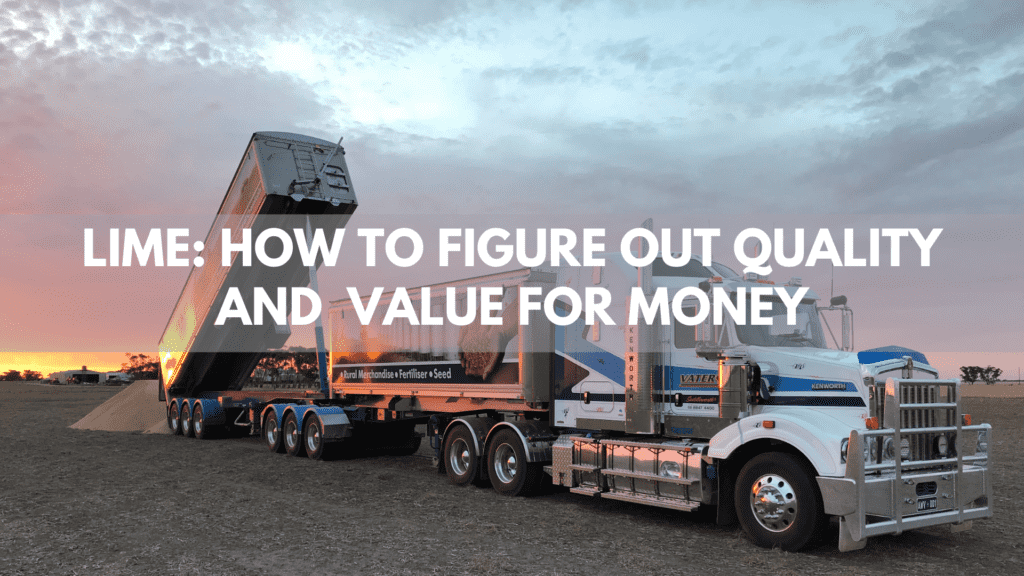You might not have guessed it, but in South Australia, more than two million hectares of land are susceptible to acidified soils. Although it’s a natural process, it becomes accelerated due to our modern farming practices with applications of things like ammonium fertilisers. When pH levels fall, crop productivity suffers with a decline in microbial activity and reduced availability of nutrients such as phosphorous, calcium, molybdenum, and magnesium, and an increase of aluminium and manganese, which can be toxic to plants. The application of lime is the most economical and effective treatment for acidic soils. In fact, the cost of liming is often reimbursed in the first few years due to the associated increase in production. On top of that, the benefits to the soil from liming can last for more than five years, so the costs can even be spread out over that period. But lime comes in all sorts of different qualities and prices. So how do you calculate whether you’re getting value for money?
Lime Quality
There is a variety of tests for lime quality that indicate how effective it will be at addressing acidity issues. Quality is an important consideration that you want to get right regarding the cost of sourcing lime. Lime of a higher quality will produce far greater results per tonne spread on the paddock than a cheap and nasty one. But how do you tell what’s good?
There is a range of indicators for assessing lime quality.
These include:
Neutralising Value (NV):
NV is a measure of lime purity. The neutralising value relates to the quantity of calcium carbonate present in the lime. A higher value indicates a greater capacity for the lime to neutralise soil acidity. For example, a high-quality lime product would have an NV value of over 80%. This number is also important when it comes to spreading. Recommended lime rates are based on a 100% pure product, which means that rates need to be calculated based on the quality of the lime sourced. For example, if lime were sourced with an NV value of 80% and recommended to be spread at 1t/ha (based on 100%), then you would need to apply 1.25t/ha.
Effective Neutralising Value (ENV):
The ENV value is a combination of lime particle size and the neutralising value (NV). Particle size is important as fine particles are difficult to accurately spread as they drift and can block up the spreader. Coarse particles are also undesirable as they take longer to neutralise soil acidity. An ideal product would have a mixture of both coarse and fine particles. It is usually preferable that 60% of the lime passes through a 0.3mm sieve. Lime particles less than 0.3mm are considered 100% effective, lime between 0.3 and 0.8mm is 60% effective, and lime greater than 0.8mm is only 10% effective. To determine an ENV value, the percentage of lime in each size range is multiplied by its associated effective rating and the product’s NV to determine the Lime’s ENV value. See the image below as an example.
A Note On Calcium and Magnesium:
It’s also worth considering calcium and magnesium content when sourcing lime. Dolomites have greater magnesium content, whereas limestone and lime sands have greater calcium levels. This can affect plants that are sensitive to very low or very high magnesium or calcium levels.
Where Can I Source Lime?
With Penrice sold out of lime at the time of writing, farmers will need to weigh up the cost of using alternative sources. There are many factors to consider, including purchase price, freight costs, mileage, and lime quality.
AW Vater & Co Grain and Transport division is sourcing high-quality lime out of the southeast. More local pits supply are also running tight. If you are interested in knowing more, contact Kim Vater 0418831440 or Tom Vater 0498474400. They can also source high-grade gypsum.
A Useful Tool:
Check out Acid Soils SA Lime Cheque calculator: It’s a super useful tool found on the GRDC Acid Soils SA Project site. It would be worth having a play with if you were planning on liming any paddocks this year and comparing sources to find your best value for money. As always, please don’t hesitate to phone any of our agronomists if you have any questions.
If you want a copy of the lime analysis from the South East, please get in touch with Tom or Sam.

